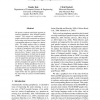Free Online Productivity Tools
i2Speak
i2Symbol
i2OCR
iTex2Img
iWeb2Print
iWeb2Shot
i2Type
iPdf2Split
iPdf2Merge
i2Bopomofo
i2Arabic
i2Style
i2Image
i2PDF
iLatex2Rtf
Sci2ools
123
click to vote
NAACL
2010
2010
Hitting the Right Paraphrases in Good Time
We present a random-walk-based approach to learning paraphrases from bilingual parallel corpora. The corpora are represented as a graph in which a node corresponds to a phrase, and an edge exists between two nodes if their corresponding phrases are aligned in a phrase table. We sample random walks to compute the average number of steps it takes to reach a ranking of paraphrases with better ones being "closer" to a phrase of interest. This approach allows "feature" nodes that represent domain knowledge to be built into the graph, and incorporates truncation techniques to prevent the graph from growing too large for efficiency. Current approaches, by contrast, implicitly presuppose the graph to be bipartite, are limited to finding paraphrases that are of length two away from a phrase, and do not generally permit easy incorporation of domain knowledge. Manual evaluation of generated output shows that our approach outperforms the state-of-the-art system of Callison-Bur...
Bilingual Parallel Corpora | Computational Linguistics | Domain Knowledge | NAACL 2010 | Paraphrases |
| Added | 14 Feb 2011 |
| Updated | 14 Feb 2011 |
| Type | Journal |
| Year | 2010 |
| Where | NAACL |
| Authors | Stanley Kok, Chris Brockett |
Comments (0)

